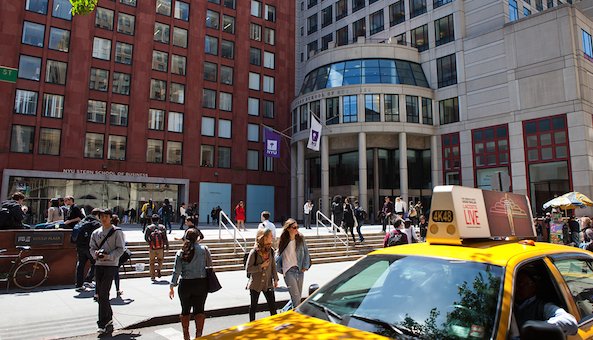
Date: 2024-04-29 Page is: DBtxt003.php txt00008630
Idea
John A. Byrne
The Cost of an Elite MBA now exceeds $200,000
Burgess COMMENTARY
Peter Burgess
The Cost Of An Elite MBA Now Exceeds $200,000

For the first time ever, a business school is telling its applicants that the total cost of an MBA degree will exceed $200,000. New York University’s Stern School of Business is asking incoming students to budget a record $203,875 to cover the tuition and living costs for its two-year MBA program.
As shockingly high as that sum appears, it is a conservative number. At most schools, tuition rises between 3% and 5% for the second year of the program and estimated living costs by a school often are between 10% and 20% lower than what many MBAs actually end up spending. Add in the opportunity cost of quitting a job for two years, and the total cost easily approaches $350,000 for most MBA students at highly ranked business schools.
The new estimate by Stern is $19,343 more than NYU said it would cost only two years ago when Stanford University’s Graduate School of Business topped the Poets&Quants’ list for the most expensive MBA program in the world. Stanford then edged out Stern with a total price tag of $185,052 versus $184,532.
The Stern numbers include $60,744 a year in tuition, $3,884 in registration fees, $25,985 for room and board, $1,980 for books and supplies, and $8,118 in “miscellaneous” charges, which include health insurance and a $1,460 fee for orientation. All told, the one-year total for Stern’s MBA program, based on a nine-month academic year, is $101,938. Last year, the average debt burden for a graduating MBA at Stern was a breathtaking $116,533.
Not surprisingly, Stanford is not far behind. In fact, depending on how you crunch the numbers, Stanford could still be number one. For a single person living on campus, Stanford said the cost of its MBA is now $202,870, a sum that includes a $4,000 global immersion trip. That’s only about $1,000 less than NYU. But if a student lives off-campus, Stanford estimates the total cost to be $212,092, with the required trip overseas.
Most business schools are aggressively increasing their scholarship support of students to help defray the escalating costs of tuition and fees. Stanford says that tuition has gone up by 16% in the past five years, but the pool of money available for scholarships has risen 44% to $12.5 million from $8.7 million. Harvard Business School, which says the total cost of its MBA is now $190,200, is handing out $31.5 million in annual scholarship support.
After NYU and Stanford, the most expensive MBA programs in the U.S. are at Wharton ($195,084), Columbia Business School ($192,936), and MIT Sloan ($192,028). The school with the biggest percentage increase in the past two years was Duke University’s Fuqua School of Business, where the cost of an MBA rose 13.2% to $169,982 from $150,202 in 2012. The increase at NYU Stern was 10.5%.
Even getting an MBA at a public university is no longer a significantly cheaper option. In fact, many of the most prominent public business schools, including the University of Virginia’s Darden School of Business and UCLA’s Anderson School of Management, now exceed the cost of the MBA program at Cornell University’s Johnson Graduate School of Management. A Darden MBA now costs $170,722 versus Cornell’s $163,784.
In most cases, the costs between a resident and a non-resident at an elite business school is negligible. At UC-Berkeley’s Haas School of Business, for example, a resident of California can expect to pay $80,215 a year for the MBA, a savings of little more than $2,500 from the non-resident’s $82,762. For the two-year program, the difference comes to about $5,000–$165,524 for the non-resident vs. $160,430.
The rising cost of attending a top business school is likely to add more fuel to the always-burning debate over whether the MBA is worth it. To Dan Bauer, a Harvard MBA who is founder and CEO of The MBA Exchange, an MBA admissions consulting firm, it’s still a no-brainer. “When I attended Harvard Business School in 1988-90, the tuition was approximately $15,000 per year, and the total cost for a married student with two kids was about $45,000 per year,” he says. “At that time, the investment felt overwhelming — especially when factoring in two years of foregone income. However, my breakeven point came just four years after graduation. Today, nearly 25 years, later, I can easily say that the ROI on attending HBS makes it the best investment of my life.”
Among the most highly ranked business schools, the best deals appear to be at the University of Texas’ McCombs School of Business and Indiana University’s Kelley School of Business. For an in-state student, the total cost of the MBA is $108,996. Even for non-residents, the price tag is comparatively reasonable: $140,064, the lowest for any Top 20 MBA program. At Kelley, the total in-state cost comes to just $104,238 versus $142,158 for an out-of-state student.
To see how much all the top schools now charge for their MBA programs and how they compare with each other, check out PoetsandQuants.com:
COMMENT
The title of this piece is wrong ... it should be that the PRICE of an elite MBA now exceeds $200,000. The sloppy choice of words when describing what people pay for things gives a very wrong impression of the structure of society and the economy. It is now more than 20 years ago that I first wrote that the biggest 'cost' in the modern economy is PROFIT. Writers about economy confuse cost and price and miss the underlying trend that productivity has been pushing costs down for the past 50 years, while (an appearance of) prosperity has been allowing prices to rise, which in turns has been very good for those with an ownership interest in profit.
This is a pretty serious mistake in a post about the MBA
Peter Burgess